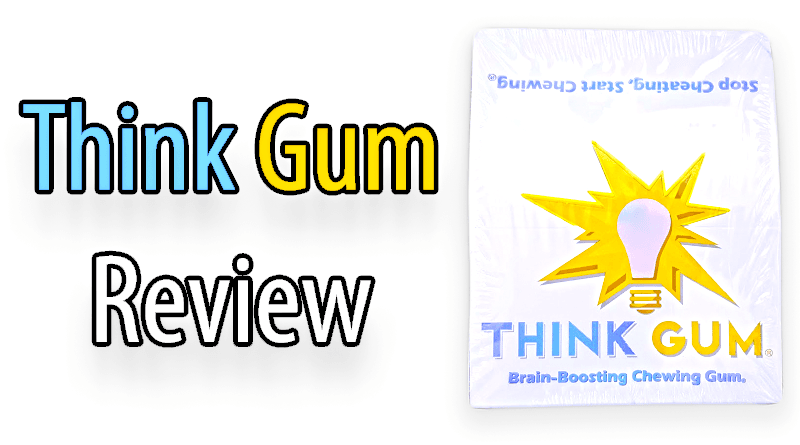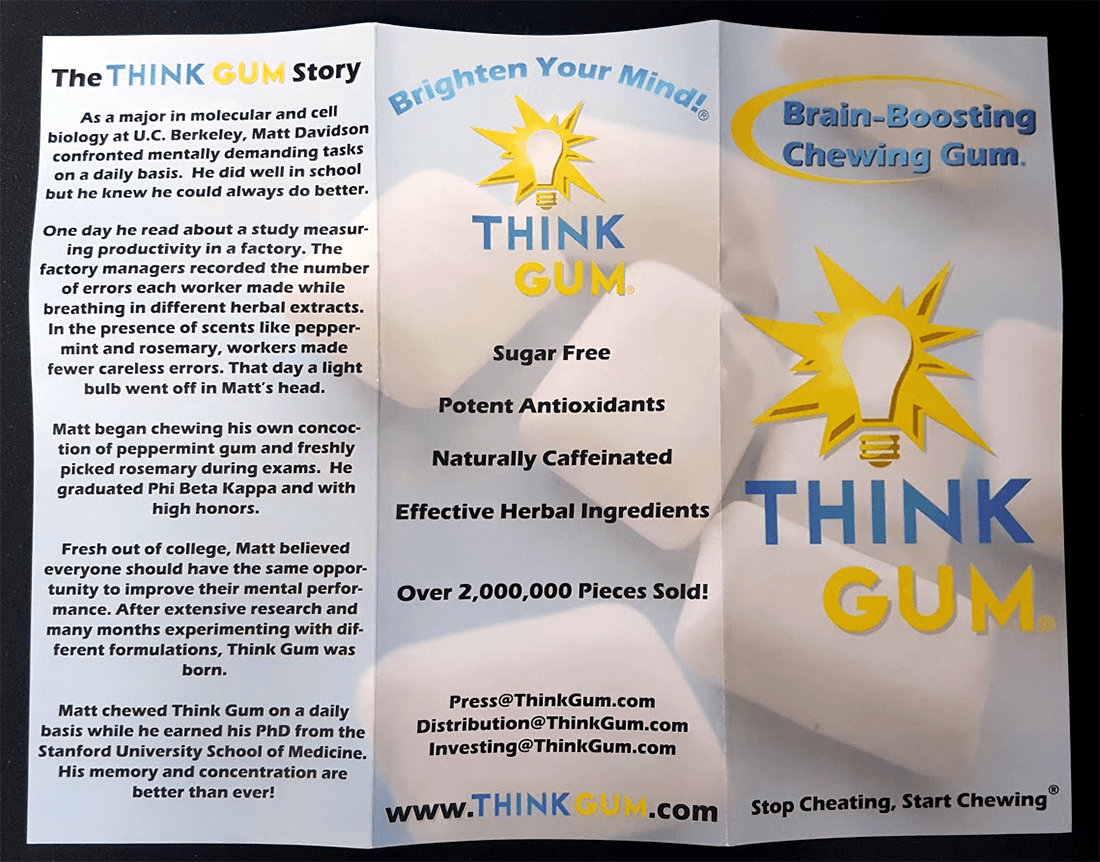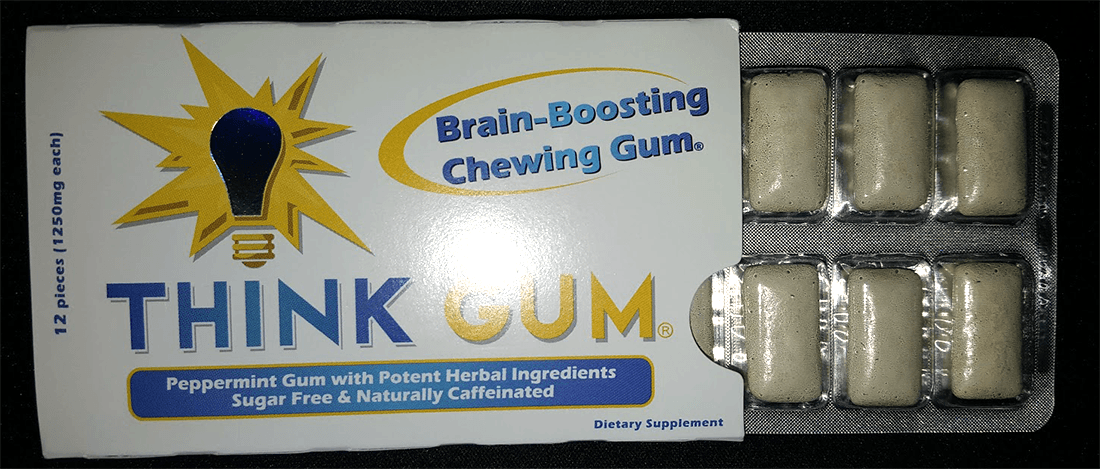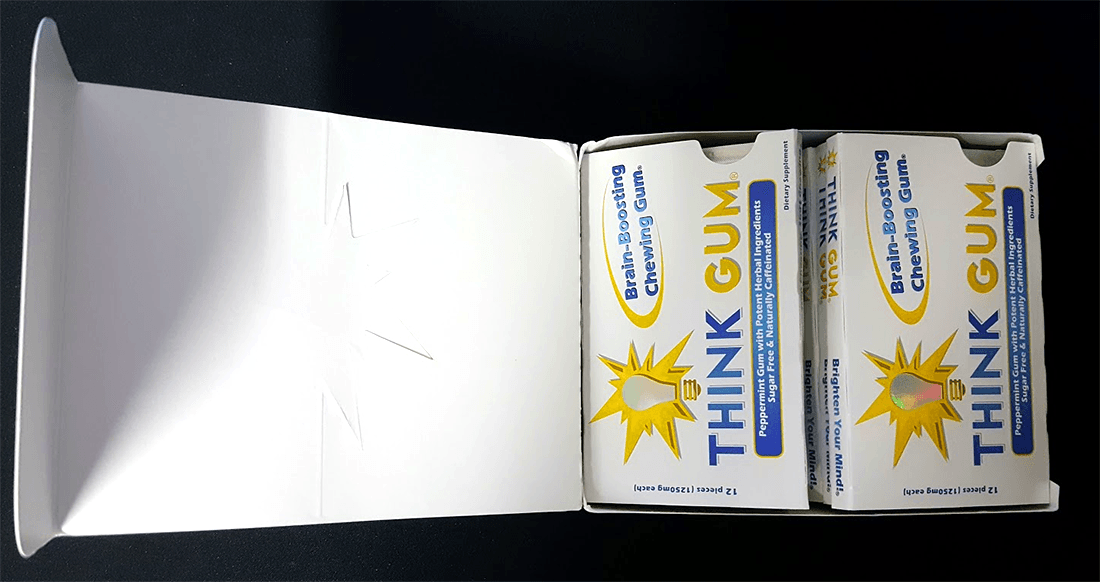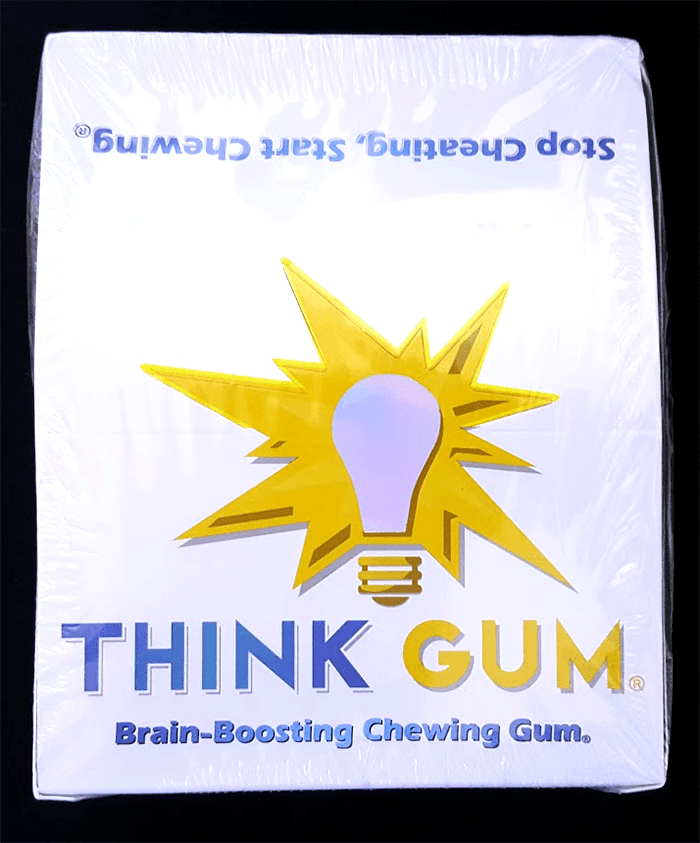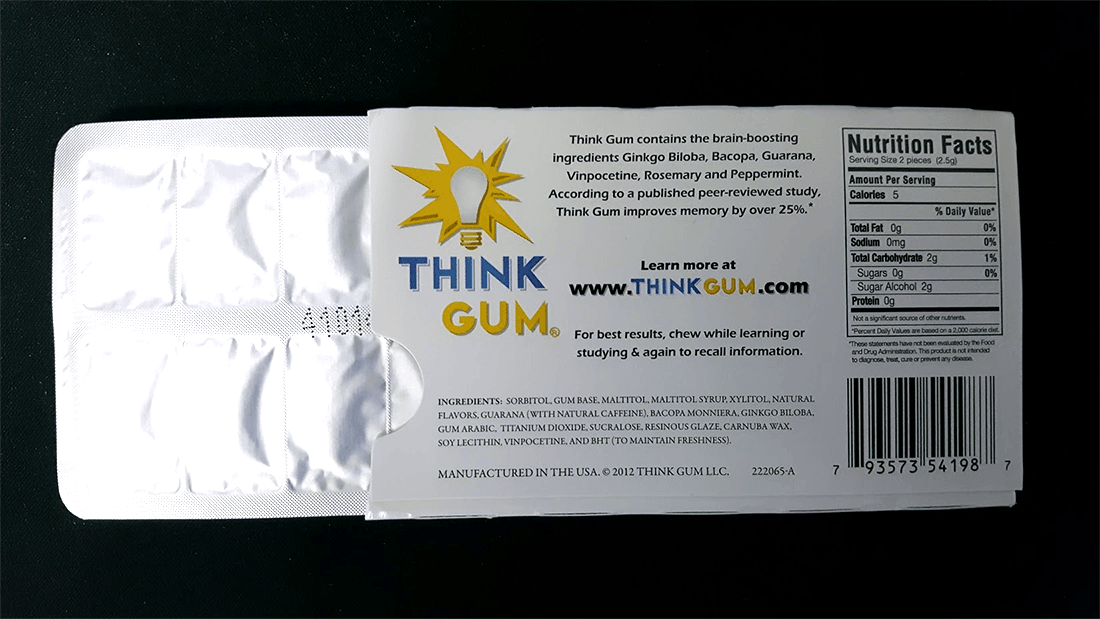Last updated on February 27th, 2020 at 09:51 pm
Think Gum has recently contacted me about their nootropic gum product. It’s quite interesting to say the least, I have never seen chewing gum that contains so many active ingredients. I’m guessing their intent is to achieve sublingual absorption thus making the product fast acting.
But, I’m a bit concerned with how well the nootropics have dissipated in the gum itself. Some nootropic powders tend to clump up or become sandy in texture, both of which are unpleasant to taste. However, I’m positive they have addressed this issue during their testing. It’s not something that would slip by when testing for quality.
Disclosure: I received this product for free to review, but it has no bearing on the review itself.
Table of Contents
A little background
I have never tried Guarana nor Vinpocetine so I cannot vouch for their effects. This will be the first time I will try them, but it will be via sublingual absorption vs the usual oral route. But I have tried Ginkgo. Normally, Ginkgo and Vinpocetine are absorbed orally through the gastrointestinal track which may or may not change their effects compared to sublingually. This is because orally administered substances need to pass through the liver before they are absorbed. Because of this, they are often times metabolized into different compounds.
Furthermore, sublingual absorption typically results in 100% bioavailability, that is 100% of the substance is absorbed. But, oral administration can have varying rates, all dependent on the substance itself.
Anyway, I’m not sure if the nootropics in this gum will interact with my current stack, but I should list out the things I’m taking just in case there are any synergies or interactions between them:
- Vitamin D3 – 5000 IU every week day
- Life Extension Two-per-day multivitamin – 1 capsule once a week
- Maca Root – 1000 mg
- Panax Ginseng – 400 mg
- Acetyl-L-Carnitine (ALCAR) – 500 mg
- Modafinil – 100 mg when needed
Research
Think Gum claims that this chewing gum can enhance memory by over 25%.[1] Looking at the study, it appears to enhance both short-term and long-term memory. However, it’s difficult to say whether this effect is the result of the nootropics or a phenomenon known as context-dependent memory. Context-dependent memory is exactly what it implies, a context is required to trigger the memory.
And gum is typically used for this purpose. However, it seems the results are conflicting when it comes to regular gum.
A study found that chewing gum produced no context-dependent memories in terms of learning words. Not only that, but it was found to significantly lower word recall indicating a detriment on memory and learning.[2]
Another study using spearmint gum found no effect on neither learning nor memory.[3] Likewise, flavourless gum and mint-flavoured strips were found to have no effect on neither learning nor memory despite a perceived effect by the participants.[4]
On the other hand, a study found that chewing and even sucking on spearmint gum led to improvements in learning words and recalling them.[5]
Incidentally, chewing in general seems to confer benefits to working memory.[6] Furthermore, chewing gum during stressful situations can increase alertness, reduce stress and anxiety, and even reduce cortisol levels.[7] Moreover, it can also improve mood and quicken reaction times as well as improve sustained attention.[8]
There is conflicting research on the benefits of regular chewing gum when it comes to memory and learning. But other benefits, like increased alertness, improved attention, and reduced stress appear to be more or less consistent. That said, Think Gum may confer complementary benefits as a result of the nootropics in it and the act of chewing itself.
Nootropics
| Nootropic | Benefit | Likely Significance in ThinkGum |
|---|---|---|
| Guarana |
| Moderate |
| Bacopa Monniera |
| Low-moderate |
| Ginkgo Biloba |
| Low |
| Vinpocetine |
| Low |
The nootropics in this product are absorbed sublingually and their effects are meant to be acute. In other words, they get absorbed through the mouth and are meant to be taken for the short-term. So when looking at research about them it’s important to note that there can be significant differences between acute and chronic effects.
There can also be significant differences between sublingual and oral administration. The research I have looked for included only acute doses, but unfortunately not sublingual administration. Also, the doses found in Think Gum are much lower than the standard capsule doses.
Guarana
Gurana is a herb that’s known to cause stimulation, improve energy, and reduce fatigue. Studies have found that acute doses of Guarana can have positive effects on long-term memory, alertness, and mood. Interestingly, low doses were found to be more effective than high doses.
And while Guarana does have caffeine, it appears that some of the benefits come from other compounds in the plant and not its caffeine content.[9]
Gurana added to a multivitamin also appears to be able to reduce fatigue and enhance cognition when mental effort is required.[10] A similar study also found Gurana to enhance cognition, in particular working memory and attention. The same study found that while a multivitamin without Gurana can enhance cognition, the addition of Gurana results in even greater enhancements to cognition.[11]
Bacopa Monniera
Bacopa is a nootropic that only starts working after a few weeks of dosing. So it’s a bit odd to find it in Think Gum. It’s unlikely to have any immediate cognitive effects. Indeed, a study found that a single dose of 300 mg of Bacopa had no effect on cognition in healthy volunteers.[12]
However, Bacopa is known to have a relaxing effect which may reduce stress and indirectly improve cognition. That said, 2 studies found that acute doses of Bacopa can in fact improve cognition as well as reduce stress and cortisol.[13] Most notably, processing speed appears to be improved by it.[14]
Ginkgo Biloba
Ginkgo is a well-known nootropic that has been used for thousands of years to treat a variety of different symptoms. However, it is typically taken in the long-term. Short-term benefits of Ginkgo are not very prominent. In fact, a combination of Bacopa and Ginkgo was found to have no acute effects on cognition.[15] Even when taken sub-chronically or chronically this combination has no effect on cognition, at least in healthy subjects.[16]
That said, other studies have shown some acute benefit of Ginkgo, most notably sustained attention.[17] But the effect was dose-dependent and was only found at 240 mg and 360 mg, which is a lot more than what is found in Think Gum. Regardless, 120 mg seems to offer noticeable memory benefits with the authors stating working memory was most notably enhanced.[18]
However, while another study also found improvements in sustained attention following acute 120 mg doses, there was no effect on working memory despite some improvements in other areas of memory.[19]
Vinpocetine
Vinpocetine is a nootropic that mainly improves blood flow to the brain. Studies assessing its acute effects are lacking. However, a small study found 40 mg of Vinpocetine can improve memory after 3 days of administration.[20] Likewise, a similar study also found improvements in memory, particulary short-term, after just 2 days of 40 mg doses.[21]
Target audience
As this product enhances context-dependent memory, it’s no doubt it is aimed at a student demographic. Chewing the Think Gum while studying and chewing it while writing an exam can help improve recall and thus improve exam grades.
But it’s not just limited to students. There are many jobs in which good learning and memory is almost an implicit requirement. In fact, some jobs require you to be up to date with the latest information. This can easily overwhelm most people if their memories aren’t good. A nootropic like Think Gum has real potential in situations like these. This is especially true if job performance can be the difference between getting a raise and getting a promotion.
Taste and Smell
Taste is definitely among the most important factors in this product. After all, it’s gum and gum should taste good. Gum shouldn’t require discipline to chew.
Honestly, I can’t tell that this is gum with nootropics in it. If given blindly, I’d guess that it was just regular peppermint-flavored gum and nothing more. The peppermint flavor is strong and definitely masks the taste of the nootropics. The flavor also seems to last a long time, more than 15 minutes. This is good because by the time I’m done chewing it most of the nootropics should have been released from the gum.
Quality
Comparing it to regular gum there’s a noticeable difference in terms of volume. Immediately upon chewing the gum shrinks considerably, probably to less than 1/2 its original size. It still feels like gum, but it’s too small to be enough of a background activity so to say. It takes a bit of mental effort to chew just because of how small it becomes.
Also, it seems that some of the nootropics have formed micro-clumps because sometimes when I’m chewing the gum I’ll bite down on what seems to be either a very tiny ball of powder or some type of hard substance. Luckily, it has no particular taste nor does it explode when chewed so it’s just a minor inconvenience.
Effects
Personally, I found the effects to come on rather quickly and this makes sense given how the nootropics are being absorbed sublingually. Surprisingly though, the gum seems to noticeably improve my focus. Maybe it’s because gum in general seems to improve focus in certain individuals but I’ve had regular gum numerous times in my life and never has it effected my focus the way this gum does. The improvement in focus is somewhat similar to that of Modafinil.
After about 10-15 minutes of chewing I notice that my cognition in general is less clouded, there’s less brainfog. As a result, my focus further improves because my thoughts are clearer and I know what I want to do next. And while the effect isn’t very strong, it’s also not weak. I’d say it’s moderate in intensity and comparable to a cup of coffee, but without the jitters.
Speaking of coffee, there seems to be a subtle effect on wakefulness. I don’t think it’s strong enough to replace coffee, nor tea for that matter, but it’s still a nice mental effect. And unlike coffee it doesn’t seem to cause any physical side effects, none that I’ve noticed that is.
While the gum has naturally-occurring caffeine, subjectively speaking I don’t think this is what’s causing the wakefulness. Rather, I attribute the effect to the Ginkgo Biloba. At least this is what it feels like to me.
As far as memory goes, I can’t say for sure if it’s having any effect. There’s no noticeable or perceivable effect on short-term memory nor long-term memory. Though, the premise of this gum is that it improves memory when you need it, i.e. during an exam. So this effect is quite difficult to measure.
Finally, chewing gum in general slightly improves my mood but this gum has a different mechanism by which it achieves this. Again, I suspect it’s the Ginkgo given how familiar it feels.
- Moderately improved focus
- Slightly improved mood
- Slightly increased wakefulness
- No noticeable effect on memory, but only in terms of non-context-dependent memory.
Packaging
The gum comes in a blister pack that’s been inserted in a thin paper wrapper. I have to admit, it’s not the best and Think Gum can improve in this area in several ways. The problem with this current packaging is:
- The blister pack tends to fall out on its own. There’s nothing really holding it in place other than friction.
- The gum in the blister pack is not tightly sealed. It has room to move and as a result it makes a rather annoying rattling sound.
- The wrapper is quite thin and easily bends just picking it up.
The packaging also doesn’t do this product any justice. The design is bland and uninspired. Plain packaging can have a double-edged effect on liking or disliking a product by amplifying either of the 2 responses.[22] If the consumer likes the product, then the plain packaging will actually enhance their subjective experience. But, if they dislike it then they will dislike it even more than if the packaging wasn’t plain.
There are many reasons why package design is so important when it comes to customer satisfaction, especially when it comes to enhancing cognition:
- It can directly influence taste perception[23][24]
- Expectations of price are mediated at least partially by design, thus modulating the perceived value of the product[25][26]
- Colors can influence the perceived potency of pharmaceutical drugs[27]
- The shape and color of pharmaceutical drugs can influence the expectation of how effective they might be[28]
There’s a plethora of data on how different aspects of packaging can affect the consumer response. One of the most important factors when it comes to nootropics is expectation. A positive expectation is likely to garner a positive response and vice-versa. So when it comes to nootropic products, it’s very important that the first impression be as positive as possible.
When a consumer has positive expectations and the nootropic product actually works then they’ll feel a complementary effect. One from the physical or biological response and one from the mental or psychological response.
Safety
As each gum is individually sealed in an aluminium blister pack it is virtually impossible for it to be adulterated without leaving evidence behind. One good thing I like about this is that it extends the expiry date of the gum by keeping it out of the air.
Furthermore, the box I received came wrapped in plastic film which ensures that any tampering will be noticeable.
Ingredients
Here are the ingredients of Think Gum in the order they list on their package. Ingredients are always listed in order from most to least so it should give you a rough estimate of just how much is in there. The active ingredients are in bold:
- Sorbitol
- Gum base
- Maltitol
- Maltitol Syrup
- Xylitol
- Natural Flavors
- Guarana – Causes stimulation via caffeine
- Bacopa Monniera – Improves memory and has a slight calming effect
- Ginkgo Biloba – Improves alertness, mood, and attention
- Gum Arabic
- Titanium Dioxide
- Sucralose
- Resinous Glaze
- Carnuba Wax
- Soy Lecithin
- Vinpocetine – Enhances blood flow to the brain
- BHT (Butylated hydroxytoluene) – Antioxidant used to preserve freshness
Conclusion
Think Gum has done a wonderful job in creating what I assume is the world’s first nootropic chewing gum. It has noticeable cognitive effects and seems to do more than what Think Gum advertises. I found it to improve my mood, attention, and alertness. However, there’s really no way to know for sure if their context-dependent memory claim actually has any meaningful real-world effects.
In terms of flavor, Think Gum’s gum offers nothing special, but isn’t bad either. Though, they have done a great job in masking the taste of the nootropics. It really does taste like regular chewing gum. Plus, they took care to make sure no micro clumps of powder are present in the gum.
One area that I think Think Gum is able to improve upon is the packaging. The blister pack is bland and sets a neutral expression of the product’s merit. But, when it comes to smart drugs, packaging can play an important role in the positive response.
| Summary of review | |
|---|---|
| Packaging | |
| Ingredients and Safety | |
| Effects | |
| Recommend? | Yes – This is a great nootropic for students, for both studying and writing exams |
| Overall Rating | |
| Visit Think Gum | |
References
- Davidson, Matthew G. “Herbal-caffeinated chewing gum, but not bubble gum, improves aspects of memory.” Appetite 57.1 (2011): 303-307.
- Johnson, Andrew J., and Christopher Miles. “Evidence against memorial facilitation and context-dependent memory effects through the chewing of gum.” Appetite 48.3 (2007): 394-396.
- Miles, Christopher, and Andrew J. Johnson. “Chewing gum and context-dependent memory effects: a re-examination.” Appetite 48.2 (2007): 154-158.
- Johnson, Andrew J., and Christopher Miles. “Chewing gum and context‐dependent memory: The independent roles of chewing gum and mint flavour.” British Journal of Psychology 99.2 (2008): 293-306.
- Baker, Jess R., et al. “Chewing gum can produce context-dependent effects upon memory.” Appetite 43.2 (2004): 207-210.
- Hirano, Yoshiyuki, et al. “Effects of chewing in working memory processing.” Neuroscience Letters 436.2 (2008): 189-192.
- Scholey, Andrew, et al. “Chewing gum alleviates negative mood and reduces cortisol during acute laboratory psychological stress.” Physiology & behavior 97.3-4 (2009): 304-312.
- Smith, Andrew. “Effects of chewing gum on cognitive function, mood and physiology in stressed and non-stressed volunteers.” Nutritional neuroscience 13.1 (2010): 7-16.
- Haskell, Crystal F., et al. “A double-blind, placebo-controlled, multi-dose evaluation of the acute behavioural effects of guaraná in humans.” Journal of Psychopharmacology 21.1 (2007): 65-70.
- Kennedy, D. O., et al. “Improved cognitive performance and mental fatigue following a multi-vitamin and mineral supplement with added guarana (Paullinia cupana).” Appetite 50.2-3 (2008): 506-513.
- Scholey, Andrew, et al. “Acute effects of different multivitamin mineral preparations with and without guaraná on mood, cognitive performance and functional brain activation.” Nutrients 5.9 (2013): 3589-3604.
- Nathan, P. J., et al. “The acute effects of an extract of Bacopa monniera (Brahmi) on cognitive function in healthy normal subjects.” Human Psychopharmacology: Clinical and Experimental 16.4 (2001): 345-351.
- Downey, Luke A., et al. “An acute, double‐blind, placebo‐controlled crossover study of 320 mg and 640 mg doses of a special extract of Bacopa monnieri (CDRI 08) on sustained cognitive performance.” Phytotherapy Research 27.9 (2013): 1407-1413.
- Benson, Sarah, et al. “An acute, double‐blind, placebo‐controlled cross‐over study of 320 mg and 640 mg doses of Bacopa monnieri (CDRI 08) on multitasking stress reactivity and mood.” Phytotherapy research 28.4 (2014): 551-559.
- Maher, Bronya FG, et al. “The acute effects of combined administration of Ginkgo biloba and Bacopa monniera on cognitive function in humans.” Human Psychopharmacology: Clinical and Experimental 17.3 (2002): 163-164.
- Nathan, Pradeep J., et al. “Effects of a combined extract of Ginkgo biloba and Bacopa monniera on cognitive function in healthy humans.” Human Psychopharmacology: Clinical and Experimental 19.2 (2004): 91-96.
- Kennedy, David O., Andrew B. Scholey, and Keith A. Wesnes. “The dose-dependent cognitive effects of acute administration of Ginkgo biloba to healthy young volunteers.” Psychopharmacology 151.4 (2000): 416-423.
- Rigney, U., S. Kimber, and I. Hindmarch. “The effects of acute doses of standardized Ginkgo biloba extract on memory and psychomotor performance in volunteers.” Phytotherapy research 13.5 (1999): 408-415.
- Elsabagh, Sarah, et al. “Differential cognitive effects of Ginkgo biloba after acute and chronic treatment in healthy young volunteers.” Psychopharmacology 179.2 (2005): 437-446.
- Subhan, Z., and I. Hindmarch. “Psychopharmacological effects of vinpocetine in normal healthy volunteers.” European journal of clinical pharmacology 28.5 (1985): 567-571.
- Coleston, Donna M., and Ian Hindmarch. “Possible memory‐enhancing properties of vinpocetine.” Drug Development Research 14.3‐4 (1988): 191-193.
- Honea, Heather, and Sharon Horsky. “The power of plain: Intensifying product experience with neutral aesthetic context.” Marketing Letters 23.1 (2012): 223-235.
- Becker, Liza, et al. “Tough package, strong taste: The influence of packaging design on taste impressions and product evaluations.” Food Quality and Preference 22.1 (2011): 17-23.
- Piqueras-Fiszman, Betina, and Charles Spence. “The influence of the feel of product packaging on the perception of the oral-somatosensory texture of food.” Food Quality and Preference 26.1 (2012): 67-73.
- Orth, Ulrich R., Daniela Campana, and Keven Malkewitz. “Formation of consumer price expectation based on package design: Attractive and quality routes.” Journal of Marketing Theory and Practice 18.1 (2010): 23-40.
- Mumcu, Yigit, and Halil Semih Kimzan. “The effect of visual product aesthetics on consumers’ price sensitivity.” Procedia Economics and Finance 26 (2015): 528-534.
- Roullet, Bernard, and Olivier Droulers. “Pharmaceutical packaging color and drug expectancy.” ACR North American Advances (2005).
- Wan, Xiaoang, et al. “Assessing the expectations associated with pharmaceutical pill colour and shape.” Food quality and preference 45 (2015): 171-182.

